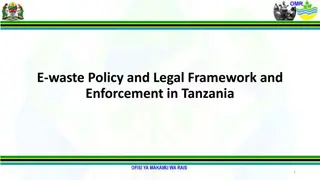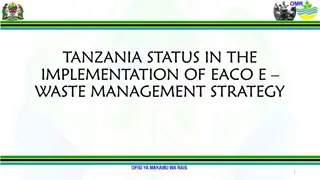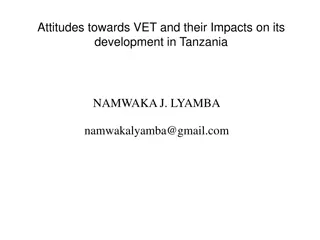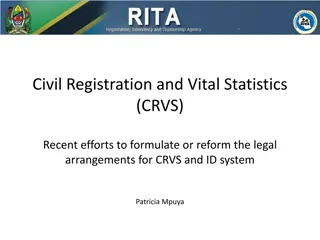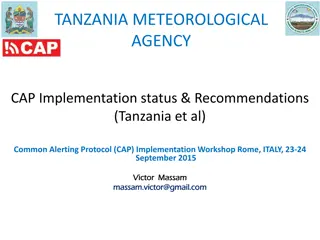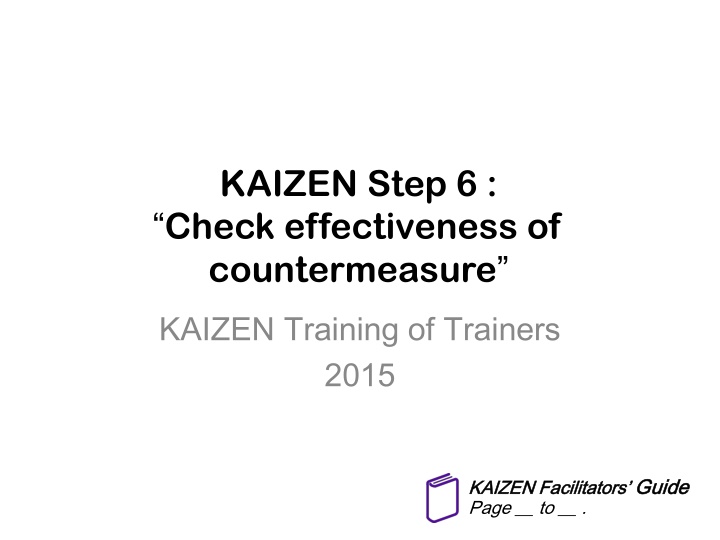
Effective Ways to Check KAIZEN Effectiveness & Improve Productivity
Learn how to evaluate the effectiveness of KAIZEN activities, identify efficient countermeasures, and enhance workplace processes. Explore steps such as situation analysis, reduction rates, and data collection after implementing KAIZEN. Find out how to standardize and optimize results for sustainable improvements.
Download Presentation

Please find below an Image/Link to download the presentation.
The content on the website is provided AS IS for your information and personal use only. It may not be sold, licensed, or shared on other websites without obtaining consent from the author. If you encounter any issues during the download, it is possible that the publisher has removed the file from their server.
You are allowed to download the files provided on this website for personal or commercial use, subject to the condition that they are used lawfully. All files are the property of their respective owners.
The content on the website is provided AS IS for your information and personal use only. It may not be sold, licensed, or shared on other websites without obtaining consent from the author.
E N D
Presentation Transcript
KAIZEN Step 6 : Check effectiveness of countermeasure KAIZEN Training of Trainers 2015 KAIZEN Facilitators KAIZEN Facilitators Guide Page __ to __ . Guide
Objectives of the session At the end of the session, trainees are able to: 1. Describe process of effectiveness check of KAIZEN activities 2. Identify effective countermeasures 3. Demonstrate the process of effectiveness check at working environment 1
KAIZEN Process STEP 7 Standardization Check effectiveness of countermeasure STEP 6 STEP 5 Implementation of countermeasure STEP 4 Identification of countermeasure STEP 3 Root Cause Analysis STEP 2 Situation Analysis STEP 1 Selection of KAIZEN theme 2
Outline of effectiveness check 1 Situation analysis 3 2 Effectiveness check - Reduction rate - Comparison Pareto chart Relation between countermeasures and effectiveness Implemented Not effective Not implemented Not effective Not implemented But effective Implemented Effective 4 Go to Step 7: Standardization 3
How to check effectiveness of KAIZEN How to check effectiveness of KAIZEN Compare frequency and reduction rate of frequency between before and after KAIZEN Check achievement to your target set in Step 2 (reduction rate) Compare other information in terms of: Cost Work labor cost effectiveness Quality Work process Human resource etc. 4
Data collection (Situation analysis after KAIZEN) Review methods of situation analysis done in KAIZEN Step 2 Conduct situation analysis in the same methods: Same data Same period of data collection Same methodologies of data collection 5
Development of a comparison Development of a comparison calculation table calculation table Before KAIZEN Cumulative frequency After KAIZEN Cumulative frequency Reduction of frequency Reduction rate (%) SQ# Contributing factors Accumulation ratio (%) Accumulation ratio (%) Frequency Frequency Number of giving wrong injectable medicines Number of giving wrong inhale medicines Giving wrong oral medicines Giving wrong volume of insulin Number of giving wrong ointment Total 1 25 25 46.3 7 7 46.7 18 72.0 2 16 41 75.9 4 11 73.3 12 75.0 3 6 47 87.0 3 14 93.3 3 50.0 4 5 52 96.3 1 15 100 4 80.0 5 2 54 100 0 15 100 2 100.0 54 - - 15 - - 39 72.2 Data of before KAIZEN Data of after KAIZEN Reduction between before and after KAIZEN Formula of reduction rate Formula of reduction rate 6
Development of comparison Pareto chart Development of comparison Pareto chart Adjusting scale as same level of before KAIZEN Before KAIZEN After KAIZEN 25 100.0 25 100.0 90.0 90.0 80.0 80.0 20 80.0 80.0 20 Accumulation ratio (%) 70.0 70.0 Accumulation ratio 15 60.0 15 60.0 Frequency Frequency 50.0 50.0 10 40.0 10 40.0 30.0 30.0 5 5 20.0 20.0 10.0 10.0 0 0.0 0 0.0 1 2 3 4 5 1 2 Contributing factor 3 4 5 Contributing factor Frequency Accumulation ratio (%) Frequency Accumulation ratio (%) Same order of the contributing factors between before and after KAIZEN even if the order of contributing factors is changed. 7
(Example) Comparison (Example) Comparison results before before and and after results between between after KAIZEN KAIZEN Before KAIZEN Cumulative frequency After KAIZEN Cumulative frequency Reduction of frequency Reduction rate (%) SQ# Contributing factors Accumulation ratio (%) Accumulation ratio (%) Frequency Frequency Number of giving wrong injectable medicines Number of giving wrong inhale medicines Giving wrong oral medicines Giving wrong volume of insulin Number of giving wrong ointment Total 1 25 25 46.3 7 7 46.7 18 72.0 2 16 41 75.9 4 11 73.3 12 75.0 3 6 47 87.0 3 14 93.3 3 50.0 4 5 52 96.3 1 15 100 4 80.0 5 2 54 100 0 15 100 2 100.0 54 - - 15 - - 39 72.2 25 100.0 25 100.0 90.0 90.0 Accumulation ratio (%) 20 80.0 20 80.0 Accumulation ratio 70.0 70.0 Frequency Frequency 15 60.0 15 60.0 50.0 50.0 10 40.0 10 40.0 30.0 30.0 5 20.0 5 20.0 10.0 10.0 0 0.0 0 0.0 1 2 Contributing factor 3 4 5 2 Contributing factor Frequency 1 3 4 5 8 Accumulation ratio (%) Frequency Accumulation ratio (%)
Breaking down your effectiveness Clarify whether each countermeasures were effective or not Relation between countermeasures and effectiveness can be categorized into 4 groups Effectiveness Effectiveness Effective Not effective Implementation Countermeasure implemented Implementation It is not effective and need It is not effective and need to review measures to review measures Implement some measures Implement some measures (DO something) (DO something) It is effective and need to It is effective and need to be standardized be standardized Need to clarity why it is Need to clarity why it is effective effective Countermeasure not implemented 9
Cont. 1. Effectiveness should be measured by each countermeasure 2. The countermeasure that is not implemented but show good effects need to be investigated the reason 3. The countermeasure that is not implemented and cannot measure effectiveness need to be implemented 10
Cont. 3. It is necessary to review countermeasures if the countermeasures were not effective 4. The countermeasures that were implemented and judged as effective will be standardized in Step 7 5. The countermeasures may cause bad effects. If bad effects are greater than effectiveness, it is necessary to review the countermeasures 11
Identify effective countermeasures Which countermeasure was leading?? Your target Achieved Expected Expected o outcome utcome Partially achieved KAIZEN Step 7 Got worse KAIZEN Step 3, 4, 5, 6 Good effect Unexpected Unexpected o outcome utcome Bad effect 12



